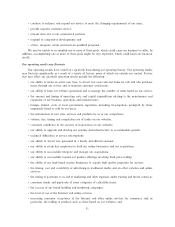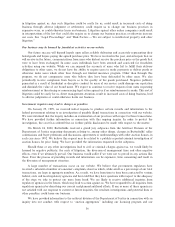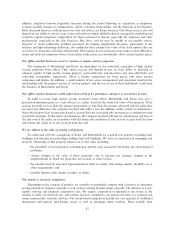eBay 2000 Annual Report Download - page 37
Download and view the complete annual report
Please find page 37 of the 2000 eBay annual report below. You can navigate through the pages in the report by either clicking on the pages listed below, or by using the keyword search tool below to find specific information within the annual report.‚ general economic conditions and economic conditions speciÑc to the Internet and e-commerce
industries.
Our limited operating history and growing competition make it diÇcult for us to forecast the level or
source of our revenues or earnings accurately. We believe that period-to-period comparisons of our operating
results may not be meaningful, and you should not rely upon them as an indication of future performance. We
do not have backlog, and almost all of our net revenues each quarter come from transactions for items that are
listed and sold during that quarter. Our operating results in one or more future quarters may fall below the
expectations of securities analysts and investors. In that event, the trading price of our common stock would
almost certainly decline.
Our failure to manage growth could harm us
We currently are experiencing a period of expansion in our headcount, facilities and infrastructure, and
we anticipate that further expansion will be required to address potential growth in our customer base and
number of listings as well as our expansion into new geographic areas, types of goods and alternative methods
of sale. This expansion has placed, and we expect it will continue to place, a signiÑcant strain on our
management, operational and Ñnancial resources. The areas that are put under strain by our growth include
the following:
‚The Websites. We must constantly add new hardware, update software and add new engineering
personnel to accommodate the increased use of our and our subsidiaries' websites and the new products
and features we are regularly introducing. This is expensive and the increased complexity of our
websites increases the cost of additional enhancements. If we are unable to increase the capacity of our
systems at least as fast as the growth in demand for this capacity, our websites may become unstable
and may cease to operate for periods of time. We have experienced periodic unscheduled downtime.
Continued unscheduled downtime would harm our business and also could anger users of our website
and reduce future revenues.
‚Customer Support. We are expanding our customer support operations to accommodate the increased
number of users and transactions on our websites. If we are unable to hire and successfully train
suÇcient employees or contractors in this area in a cost eÅective manner, users of our websites may
have negative experiences, and current and future revenues could suÅer or our margins may decrease.
‚Customer Accounts. Our revenues are dependent on prompt and accurate billing processes. If we are
unable to grow our transaction processing abilities to accommodate the increasing number of
transactions that must be billed, our ability to collect revenue will be harmed.
We must continue to hire, train and manage new employees at a rapid rate. The majority of our
employees today have been with us less than one year and we expect that our rate of hiring will continue at a
very high pace. If our new hires perform poorly, or if we are unsuccessful in hiring, training and integrating
these new employees, or if we are not successful in retaining our existing employees, our business may be
harmed. To manage the expected growth of our operations and personnel, we will need to improve our
transaction processing, operational and Ñnancial systems, procedures and controls. This is a special challenge
when we acquire new operations with diÅerent systems. Our current and planned personnel, systems,
procedures and controls may not be adequate to support our future operations. We may be unable to hire,
train, retain and manage required personnel or to identify and take advantage of existing and potential strategic
relationships and market opportunities.
We may not maintain proÑtability
We believe that our continued proÑtability will depend in large part on our ability to do the following:
‚ maintain suÇcient transaction volume to attract buyers and sellers;
‚ manage the costs of our business, including the costs associated with maintaining and developing our
websites, customer support and international and product expansion;
32
























